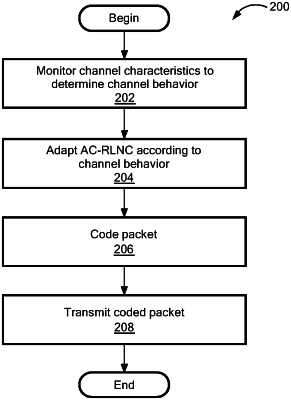| CPC H04L 69/324 (2013.01) [H04L 1/0001 (2013.01); H04L 1/004 (2013.01); H04L 1/0041 (2013.01); H04L 1/0045 (2013.01); H04L 1/0076 (2013.01); H04L 1/12 (2013.01); H04L 1/1867 (2013.01); H04L 45/24 (2013.01); H04L 45/70 (2013.01); H04L 47/38 (2013.01); H04W 28/0231 (2013.01); H04W 28/0257 (2013.01); H04W 40/12 (2013.01)] | 20 Claims |

|
1. A computer implemented method to provide adaptive causal network coding, the method comprising:
generating, by a sender, a first coded packet for transmission in a first communication channel, wherein the first coded packet is a combination of a subset of a first number of information packets within a sliding window;
estimating a channel behavior of the first communication channel using information received or determined by the sender, wherein the information is based upon one or more coded packets transmitted from the sender to a receiver over the first communication channel;
adaptively adjusting a ratio of a number of new information packets and a number of retransmitted information packets in at least a second coded packet to be transmitted in the first communication channel subsequent to the first coded packet, wherein the ratio of the number of new information packets and the number of retransmitted information packets to include in the at least one second coded packet is based on the estimated channel behavior; and
adaptively adjusting a size of the sliding window to include the adaptively adjusted number of new information packets and the number of retransmitted information packets within the sliding window, wherein the adaptively adjusting the size of the sliding window is determined by at least a round trip time (RTT) and a maximum number of information packets that are allowed to overlap within the sliding window.
|